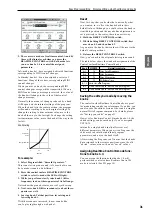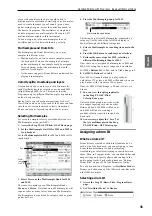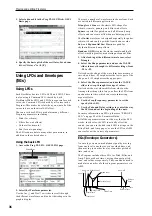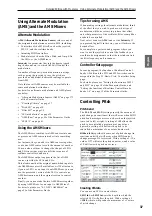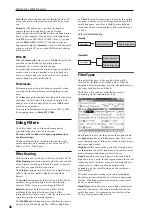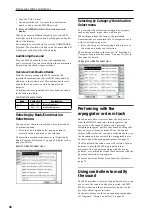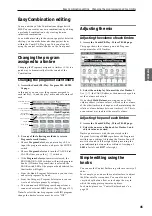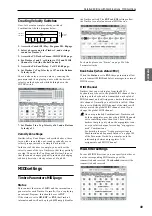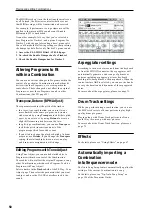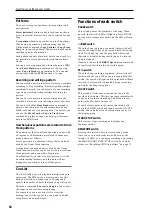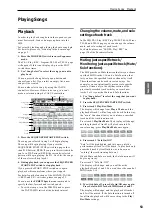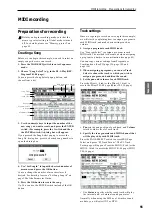
Detailed Editing with Programs Using the Amp section
41
Program
Combination
Sequencer
Effect
Arpeggio
Drum Track
Global
Media
Keyboard Track
This lets you vary the volume relative to the note you
play.
For details, please see “Keyboard Track” on page 40.
Amp Modulation
Velocity Intensity
is used by most programs to
decrease the volume of softly played notes and
increase the volume of strongly played notes, and the
Amp Modulation parameter adjusts the depth of this
control.
Normally you will set Amp Modulation to positive (+)
values
. As this setting is increased, there will be greater
volume difference between softly played and strongly
played notes.
LFO1/2
Specifies how the LFO’s will produce cyclic changes in
volume (tremolo effect).
The volume will be affected by the LFO(s) for which
you set an LFO1 Intensity, LFO2 Intensity value.
Intensity
(AMS Intensity) adjusts the depth by which
the tremolo effect produced by the LFO will be affected
when you assign an AMS (LFO1 AMS, LFO2 AMS).
For example, if you set AMS to JS-Y: CC #02, tremolo
will be applied when you push the M50’s joystick
down (toward yourself), or when CC#02 is received.
Amp EG
The Amp EG lets you control how the volume changes
over the course of a note.
Every instrument has its own characteristic volume
envelope. This is part of what gives each instrument its
identifiable character.
Conversely, by changing the volume contour–for
instance, applying a string-like Amp EG curve to an
organ multisample– you can produce interesting and
unusual sounds.
Drive
The Drive circuit adds saturation and overdrive to the
sound, for everything from subtle fattening to drastic
distortion. Unlike an overdrive effect, Drive processes
each voice individually, so the timbre stays the same
regardless of how many voices are being played.
The two main parameters, Drive and Low Boost, work
together to create the overall effect.
Drive
controls the amount of edge and bite in the
timbre. Low settings will produce mild saturation, and
higher settings create more obvious distortion.
Often, it’s useful to increase the Low Boost along with
the Drive.
Note:
even when the Drive amount is set to 0, the
Drive
circuit still affects the timbre. If your goal is a
completely pristine sound, use the Bypass control
instead.
Low Boost
is a special low-frequency EQ which
controls the body character of the sound. The specific
EQ frequencies affected will change with the Drive
setting.
Higher amounts increase the bass boost, and will also
intensify the effect of the Drive parameter.
Piano
Organ
Strings
Summary of Contents for EASYSTART M50
Page 1: ...3 E Owner s Manual ...
Page 84: ...Arpeggiator function 78 ...
Page 88: ...Drum Track function 82 ...





